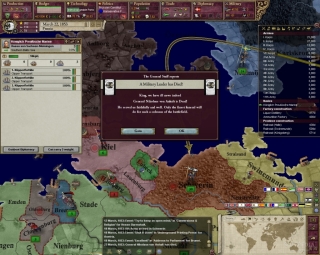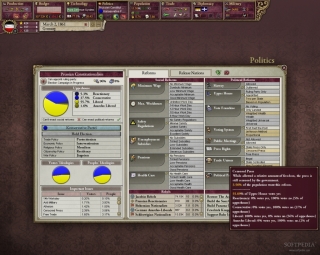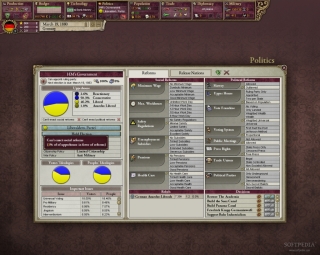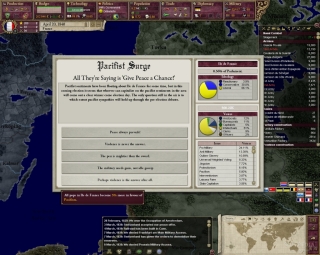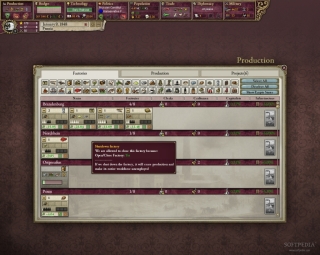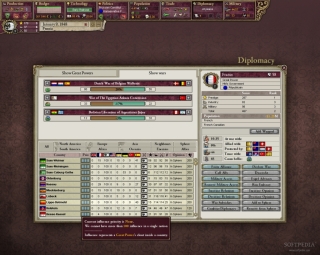Two weeks, broken up by a visit to Gamescom, is the time I've taken to review Victoria II, the grand strategy title from Paradox Interactive that focuses on the social and political change Europe and the world experienced beginning with 1836 and went on for about a century before the early days of the World War II era kicked in.
This is the kind of experience where a good and dedicated player will learn something new and interesting after 3 months of daily play and reviews are not really enough to actually show off the amount of detail that the developers managed to pour into the game but here's an honest effort from a long term fan of the Paradox Interactive way of making games, that is complex, with an eye to both enjoyment and historicity.
Victoria II aims very high and mostly succeeds in creating a vast sandbox where politics, trade, industry, science, military tactics, diplomacy and social changes combine to create outcomes that never seem completely separated from history while never following the books letter for letter. It's a dream experience for all those who want to explore the big “What If” questions of the period, from how Austria could create a German Empire to how the Ottoman Empire could avoid its long decline and dominate the Middle East and half of Europe as it has once done.
Dominating Europe as a unified Germany, reuniting Italy and subduing Austria, creating Romania and throwing off the shackles of Ottoman power, extending Russia's influence in North America while facing both Communist and Reactionary revolts at home, making Mexico a Great South American Power are just a few of the things I've done in Victoria II and enterprising gamers will no doubt find other fun challenges to set for themselves once they get a hang of the mechanics.
Gameplay
The complexity of the game mechanics in Victoria II is extraordinary. It's no wonder that Paradox Interactive has decided to just offer one Grand Campaign options in the single player given the huge amount of detail needed to set up the game for just one start date.
The player is the overall ruling entity behind a state of the XIX century. They have control over almost everything that happens in the state and they can choose the aims of the nation for the coming decades and the best way to try and achieve them. This means diplomacy is simulated, trade is in, wars are almost inevitable, new ideas need to be discovered and employed and colonies are needed to fuel growth. A World War like situation or two might also pop up.
The most interesting aspect is the diplomatic dance that was so much a part of the history of the period. The eight Great Powers are really a cut above their peers, with the military, commercial and diplomatic power to attract smaller nations into their Sphere of Influence and with massive clashes starting when the spheres are violated. Each nation generates influence points that can be spent on other states in a variety of ways and the whole system is clear and fluid, allowing situations where Mexico becomes a great power bringing all of South America into its sphere. The game gives significantly less options when playing a country which is not yet a Great Power, but the goal is always in sight and allows even nations like the Two Sicilies to tangle with the big boys.
Its very interesting to watch how Russia, Austria and Prussia all spend influence to get Krakow to like them, become an ally and be part of their common market. And often influence battles degenerate into actual wars, especially on the crowded little European continent and among those countries that lack the abilities to expand through colonies.
The military aspect of Victoria II is not overtly developed and Paradox seems to have made some questionable choices, like offering four types of cavalry in an epoch when infantry dominated the battlefield and simulating advances in artillery power only through technological advance. Battles can sometimes feel like a bit of ping pong, with the AI at a severe disadvantage because it fails to chase and destroy all retreating armies.
Another very important element of the game is industrialization, which happens differently depending on policies. More liberal countries will opt to allow their capitalists to do what they want, pooling capital, creating factories and then recruiting the craftsmen and the clerks needed to turn raw materials into finished goods. The risks are that the capitalists will go bankrupt (and they often do investing in a lot of caned food and fertilizer) but the process can be quite quick, especially if your market oriented techs are developed.
There's also the options to adopting a policy that encourages the state to intervene, creating factories directly and building railroads or just offering subsidies where they are needed. Victoria II does not comment on the effectiveness of the opposing policies and there success depends a lot on the country and on the make up of the population, not to mention raw material presence and research advances.
Another huge part of the game is linked to controlling population and making sure that you don't loose them to radical ideologies and militancy. As the time line progresses farmers and laborers will become more educated and turn into craftsmen and clerks, some of the them even getting to capitalist or clergy. The social movements depend on a number of factors, like taxes, opportunities, political consciousness and militancy.
In a way everything in Victoria II is somehow linked to populations groups, their needs and their aspirations, but Paradox wisely chose not to emphasize this, letting players experience all the aspects separately and discover the subtle influences that flow from one area to another.
One word of caution: leave the detailed views in the population screens alone for the first game or two. There's a ton of detail there and tweaking it can really make a difference to how a country runs but the effects are more visible when playing an underdog, which is not really advisable in the beginning, even for players who have experience with the first Victoria or other Paradox grand strategy titles. When you've got some titles under your belt pause the game after few years and just look around, messing with the sorting options and the detailed view sections, and marvel a bit at how well the developers have managed to simulate the societies that players control.
The first version of Victoria II, which is labeled 1.1, has a few teething issues. The rebels, especially the Jacobins, seem to be quite a bit more powerful than they should. I personally fell pray to their fighting prowess and numbers as Austria when I refused to enact any political reforms and got to a point in 1860 where I had the army to take the rebels out despite them spawning in every province about ever two years but the country was pretty much ungovernable and any military move outside the borders was virtually impossible. Some players are also reporting that some types of population do not work as intended, mainly because they require more goods than they should to be promoted and to perform their duties.
Graphics and audio
Victoria II looks good for the genre it inhabits. The zoomed out map is textured and informative, allowing for a lot of information to easily be conveyed to the gamer and the interface has been specifically designed to allow quick access to everything that is important and as much info as possible, with layers of tooltips that appear as soon as you hover your mouse around a number or an icon.
There can be a lot of information to dig through at times so make sure you pause the game when checking out anything that has a percentage nearby.
The audio is also very much suited to the period, with the soundtrack managing to capture the joy of life and the hard edge of the XIX century. The game does not really need it to be great but Paradox is getting better and better at providing the small details the make the experience feel special in its entirety.
Multiplayer
The multiplayer experience in Victoria II is pretty solid, given that you have the group of friends to play the game with and the time to spend on it. A player must be the host, usually the one with the best connection, and forum reports suggest that games with 4 to 8 people work the best, especially when everyone is controlling a major power.
The Good
- Complex simulation
- Social and political dynamics
- User Interface presentation
The Bad
- Complex simulation
- Late game slow down
- Rebel bug
Conclusion
Sure, it's a game where numbers and percentages at times matter more than clever strategy or quick action, but the beauty is that it combines a lot of sociology, a lot of politics, a lot of diplomacy and a lot of history into an attractive package that any lover of strategy, the XIX century or historical reenactments can understand in a few days and enjoy for a few months.
 14 DAY TRIAL //
14 DAY TRIAL // 
